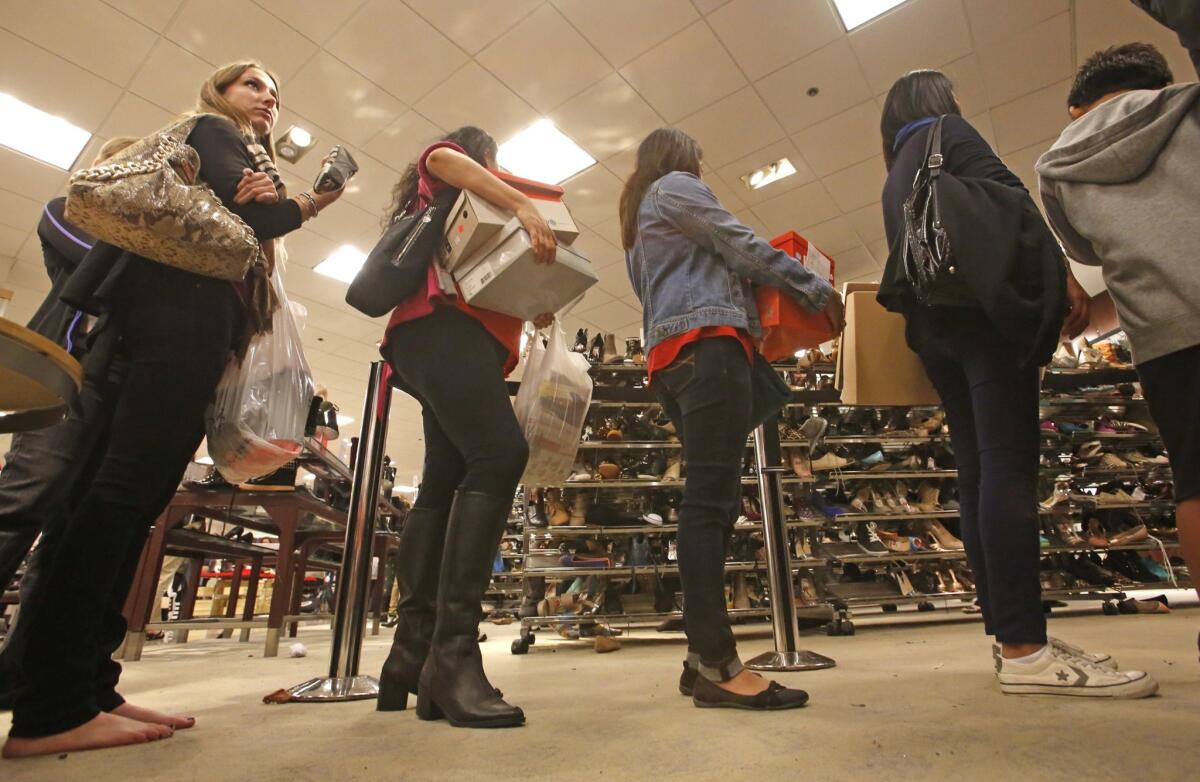ShopperTrak: Sales on Thanksgiving and Black Friday rise just 2.3%

U.S. retailers eked out a 2.3% sales gain on Thanksgiving and Black Friday, in line with a prediction for the weakest holiday results since 2009.
Sales at bricks-and-mortar stores on Thanksgiving and Black Friday increased to $12.3 billion, according to a report Saturday from ShopperTrak. The Chicago researcher reiterated its prediction that sales for the entire holiday season will rise 2.4%, the smallest gain since the last recession.
Retailers offered more and steeper deals that, although attracting shoppers, may hurt fourth-quarter earnings. Many consumers showed up prepared to zero in on their favored items while shunning the impulse buys that help retailers’ profits.
“You could get the same deals online as you could get in the store, and yet there were still a ton of people out there,” said Charles O’Shea, a senior analyst at Moody’s Investors Service in New York. Going out to stores, he said, “is part of the experience.”
About 97 million people planned to shop online or in stores on Black Friday, with about 140 million intending to do so Thanksgiving through Sunday, the National Retail Federation said. That’s down from 147 million last year.
With more stores opening on Thanksgiving, sales were pulled forward from Black Friday, said Bill Martin, ShopperTrak’s founder. Sales on Black Friday fell 13.2% from last year, with foot traffic down 11.4%. Foot traffic for the combined Thanksgiving-Black Friday period rose 2.8% to more than 1.07 billion store visits, ShopperTrak said.
“The consumers really responded to Thursday’s openings, actually more than anybody anticipated,” Martin said.
Jennifer Doval had an easier time getting to the stores for her Black Friday shopping this year at the Mall of America in Bloomington, Minn.
“It’s just quiet. I don’t know if it’s because it was open yesterday,” Doval, 42, from nearby Edina, said Friday while shopping for clothes for her 12-year-old daughter and presents for her parents. She arrived at 7 a.m. and was “shocked how empty the parking ramps were.”
The continued rise of e-commerce also may have kept some shoppers at home. Online sales rose 20% from last year on Thanksgiving and 19% on Black Friday, IBM Corp. said Saturday. Target Corp. said it had twice as many online orders early on Thanksgiving morning as a year earlier. Amazon.com Inc. attracted shoppers by offering discounts as often as every 10 minutes during the holiday week.
“I went a little happy doing Amazon lightning deals, and I got my toy shopping done last Friday at Wal-Mart’s pre-Black Friday sale,” said Swati Parekh, 44, of Towaco, N.J., who didn’t go shopping on Black Friday.
Faced with smaller crowds of less confident consumers, as well as six fewer days between Thanksgiving and Christmas than last year, retailers poured on margin-eating discounts to grab market share Friday.
More than a dozen retailers also opened earlier or for the first time on Thanksgiving Day. Among the first-timers were Macy’s Inc., Kohl’s Corp. and J.C. Penney Co., which is in the midst of turnaround efforts. About 33 million shoppers intended to shop on Thanksgiving, said the National Retail Federation, a Washington trade group.
Wal-Mart Stores Inc. said it served more customers on Thanksgiving than the 22 million who shopped on the holiday last year, without providing a specific figure. The Bentonville, Ark.-based chain processed more than 10 million register transactions from 6 p.m. to 10 p.m. and sold 2.8 million towels, 2 million televisions and 1.4 million tablets.
Some shoppers are taking advantage of the discounts and focusing only on the items they need while shunning unplanned purchases of goods that retailers have kept closer to full price.
Giselle Suazo, 28, and her husband, Luis Aracena, 26, of Lawrence, Mass., shopped with their 7-year-old daughter and 3-year-old son at a Wal-Mart store in Salem, N.H., on Friday afternoon.
Although the couple plan to spend slightly more money this year than last, their budget remains tight after moving into a new apartment.
The family is shopping with a plan, and Suazo prepared by looking at retailers’ websites last week.
“You’ve got to know specifically what you want to buy,” said Suazo, who had two Barbie dolls in her cart marked down to $8 from $20.
There was “a lot of mission shopping, and you don’t normally see that until later in the season,” said Maureen Bausch, executive vice president at the Mall of America.
That’s bad news for retailers, who normally get about 20% of their holiday sales from impulse purchases, said Marshal Cohen, chief retail analyst for NPD Group Inc.
Thom Blischok, chief retail strategist with Booz & Co. in San Francisco, said every one of the 300 shoppers he spoke with on Thanksgiving and Black Friday had a list.
“They had an absolute plan,” said Blischok, who hit malls and shopping strips around Paradise Valley, Ariz. “I found virtually no browsing.”
Some shoppers even walked away empty-handed. Katherine Miao said she had been at the Mall at Short Hills in New Jersey with her parents and sister for almost eight hours on Black Friday without getting the black high-heeled shoes she was looking for.
“The store had a blue shade on sale, but the black shoe wasn’t, so the manager tried to talk me into different black shoes,” said Katherine, a 16-year-old high school student. “But I had my eyes on the first pair, and I ended up not buying anything.”
More to Read
Inside the business of entertainment
The Wide Shot brings you news, analysis and insights on everything from streaming wars to production — and what it all means for the future.
You may occasionally receive promotional content from the Los Angeles Times.










